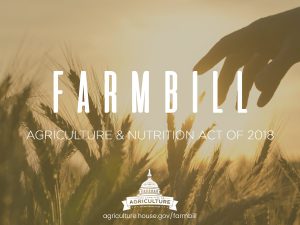Congress passes the 2018 Farm Bill
 After months of stalemate, Congress has passed the Farm Bill in a rush — the conference committee version of the bill was released on Monday evening, the Senate passed it Tuesday, and the House passed it on Wednesday. Now it’s heading to the President’s desk for signature.
After months of stalemate, Congress has passed the Farm Bill in a rush — the conference committee version of the bill was released on Monday evening, the Senate passed it Tuesday, and the House passed it on Wednesday. Now it’s heading to the President’s desk for signature.
We will provide a detailed analysis in the coming weeks, but here are some of the key takeaways:
- Overall, the final Farm Bill looks a lot like the Senate version of the bill. That means that it is mostly a status quo bill that supports large-scale industrial agriculture, but it’s not as bad as the House version was.
- We succeeded in keeping out the King Amendment. Rep. King’s provision would have usurped local and state laws on food and agriculture, mandating a one-size-fits-all approach for environmental standards, labor rights, animal welfare, and community safety. It would have eliminated laws adopted by local communities to address problems like Dicamba pesticide drift, to set standards for food quality and animal welfare (such as cage-free eggs or crate-free veal), and even laws that simply allow consumers to know whether their purchases support their local farming communities. The exclusion of the King Amendment keeps power in the local communities.
- The Conservation Stewardship Program (CSP) remains in existence, although with reduced funding. For decades, CSP has provided funds to help farmers who choose to implement practices on their farm that promote long-term sustainability. This has enabled farmers to help promote healthy soil, water, air, and wildlife habitats that benefit everyone — and, at the same time, improve the profitability of their operations. CSP especially benefits family farmers who are invested in sustaining their land’s productivity for generations to come. Although the reduction in funding is a problem, the rejection of the House proposal to eliminate the whole program is another important victory.
- The bill provides permanent, baseline funding for several small programs that help local food producers through the Beginning Farmer and Rancher Development Program, Outreach and Assistance for Socially Disadvantaged and Veteran Farmers and Ranchers Program (Section 2501), Value Added Producer Grants, and Farmers Market and Local Food Promotion Program. These programs are now combined under the names Farming Opportunities Training and Outreach (FOTO) and the Local Agriculture Market Program (LAMP).
- The bill legalizes hemp at the federal level by defining hemp as an agricultural product and removing it from the list of Schedule 1 controlled substances in the Controlled Substances Act. This not only allows farmers to raise hemp, but makes it eligible for things like normal funding and insurance options. States can still restrict hemp, but the removal of hemp from the list of controlled substances will make state-level work substantially easier.
- On the downside, caps on subsidies for wealthy individuals did not make it into the bill, and instead the bill actually expands existing loopholes that will allow more subsidies to go to wealthy mega-farms.
If you look at our action alert about the conference committee discussions, you’ll see that we got most of what we asked for, in terms of the Senate bill provisions dominating over the House’s terrible version of the bill. So we consider the final result as good news when compared to what it might have been. But both versions of the bill were overwhelmingly geared to support the current industrial-scale, monoculture-focused agriculture that dominates our food system.
We worked for important changes that didn’t make it into either version of the bill, such as the PRIME Act to help increase access to small-scale meat processors and reform of the Checkoff programs that fund Big Ag advertising.
Much more work is needed in order to build an agricultural system that truly supports family farmers and healthy food. We must keep fighting for more reform at the federal and state levels.